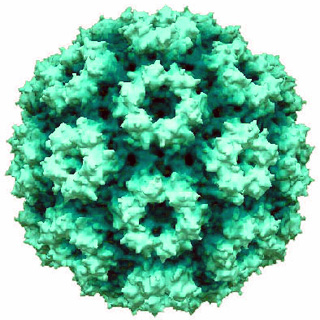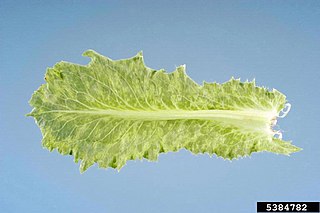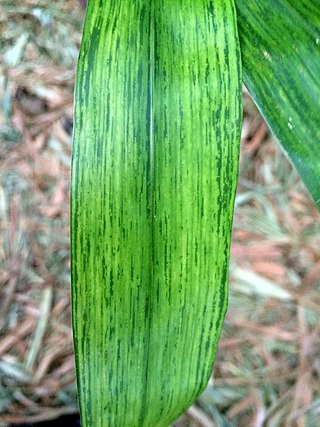Cauliflower mosaic virus (CaMV) is a member of the genus Caulimovirus, one of the six genera in the family Caulimoviridae, which are pararetroviruses that infect plants. Pararetroviruses replicate through reverse transcription just like retroviruses, but the viral particles contain DNA instead of RNA.

Plant viruses are viruses that affect plants. Like all other viruses, plant viruses are obligate intracellular parasites that do not have the molecular machinery to replicate without a host. Plant viruses can be pathogenic to vascular plants.
Phycodnaviridae is a family of large (100–560 kb) double-stranded DNA viruses that infect marine or freshwater eukaryotic algae. Viruses within this family have a similar morphology, with an icosahedral capsid. As of 2014, there were 33 species in this family, divided among 6 genera. This family belongs to a super-group of large viruses known as nucleocytoplasmic large DNA viruses. Evidence was published in 2014 suggesting that specific strains of Phycodnaviridae might infect humans rather than just algal species, as was previously believed. Most genera under this family enter the host cell by cell receptor endocytosis and replicate in the nucleus. Phycodnaviridae play important ecological roles by regulating the growth and productivity of their algal hosts. Algal species such Heterosigma akashiwo and the genus Chrysochromulina can form dense blooms which can be damaging to fisheries, resulting in losses in the aquaculture industry. Heterosigma akashiwo virus (HaV) has been suggested for use as a microbial agent to prevent the recurrence of toxic red tides produced by this algal species. Phycodnaviridae cause death and lysis of freshwater and marine algal species, liberating organic carbon, nitrogen and phosphorus into the water, providing nutrients for the microbial loop.

Cowpea chlorotic mottle virus, known by the abbreviation CCMV, is a virus that specifically infects the cowpea plant, or black-eyed pea. The leaves of infected plants develop yellow spots, hence the name "chlorotic". Similar to its "brother" virus, Cowpea mosaic virus (CPMV), CCMV is produced in high yield in plants. In the natural host, viral particles can be produced at 1–2 mg per gram of infected leaf tissue. Belonging to the bromovirus genus, cowpea chlorotic mottle virus (CCMV) is a small spherical plant virus. Other members of this genus include the brome mosaic virus (BMV) and the broad bean mottle virus (BBMV).

Papaya ringspot virus (PRSV) is a pathogenic plant virus in the genus Potyvirus and the virus family Potyviridae which primarily infects the papaya tree.

Apple mosaic virus (ApMV) is a plant pathogenic virus of the family Bromoviridae. It is named after its symptoms that were first present on apples. ApMV is a positive sense RNA based virus. The disease itself has several synonyms including Mild Apple Mosaic Virus, Hop Virus, Rose Mosaic Virus, and European Plum Line Patten Virus. It causes a severe yield reduction and decreased life-expectancy of fruit trees.
Bean yellow mosaic virus is a plant pathogenic virus in the genus Potyvirus and the virus family Potyviridae. Like other members of the Potyvirus genus, it is a monopartite strand of positive-sense, single-stranded RNA surrounded by a capsid made for a single viral encoded protein. The virus is a filamentous particle that measures about 750 nm in length. This virus is transmitted by species of aphids and by mechanical inoculation.

Bidens mottle virus (BiMoV) is a pathogenic plant virus in the plant virus family Potyviridae. BiMoV is a flexuous filamentous particle, 720 nm long, and belongs to the Potyviridae genus Potyvirus. Like other viruses in this genus, Bidens mottle virus is transmitted both mechanically by sap and by aphids in a stylet-borne fashion.
Clover yellow mosaic virus (ClYMV) is a plant pathogenic virus in the genus Potexvirus and the virus family Alphaflexiviridae. Its flexuous rod-shaped particles measure about 539 nm in length.

Cucumber mosaic virus (CMV) is a plant pathogenic virus in the family Bromoviridae. This virus has a worldwide distribution and a very wide host range, having the reputation of the widest host range of any known plant virus. It can be transmitted from plant to plant both mechanically by sap and by aphids in a stylet-borne fashion. It can also be transmitted in seeds and by the parasitic weeds, Cuscuta sp. (dodder).

Cymbidium mosaic virus (CymMV) is a plant pathogenic virus of the family Alphaflexiviridae.
Papaya mosaic virus (PapMV) is a plant pathogenic virus in the genus Potexvirus and the family Alphaflexiviridae. PapMV is a filamentous, flexuous rod, 530 nm in length.
Pepper mottle virus (PepMoV) is a plant pathogenic virus in the genus Potyvirus and the virus family Potyviridae. Like other members of the Potyvirus genus, PepMV is a monopartite strand of positive-sense, single-stranded RNA surrounded by a capsid made for a single viral encoded protein. The virus is a filamentous particle that measures about 737 nm in length. Isolates of this virus has been completely sequenced and its RNA is 9640 nucleotides long. This virus is transmitted by several species of aphids in a nonpersitant manner and by mechanical inoculation.
White clover mosaic virus (WClMV) is a plant pathogenic virus in the genus Potexvirus and the family Alphaflexiviridae. WClMV is a filamentous, flexuous rod, 480 nm in length and 13 nm wide.

Potexvirus is a genus of pathogenic viruses in the order Tymovirales, in the family Alphaflexiviridae. Plants serve as natural hosts. There are 48 species in this genus, three of which are assigned to a subgenus. Diseases associated with this genus include: mosaic and ringspot symptoms. The genus name comes from POTato virus X).

Bamboo mosaic virus (BaMV) is a plant pathogenic virus in the genus Potexvirus and the family Alphaflexiviridae. BaMV is a filamentous, flexuous rod, 490 nm in length and 15 nm in width. The virus has been fully sequenced and it is 6366 nucleotides long.
Commelina mosaic virus (CoMV) is a plant pathogenic virus in the genus Potyvirus and the virus family Potyviridae. Like other members of the Potyvirus genus, CoMV is a monopartite strand of positive-sense, single-stranded RNA surrounded by a capsid made for a single viral encoded protein. The virus is a filamentous particle that measures about 707-808 nm in length. This virus is transmitted by two species of aphids, Myzus persicae and Aphis gossypii, and by mechanical inoculation.

Abutilon mosaic virus (AbMV) is a virus of the genus Begomovirus. It infects Abutilon species, notably the flowering maple, Abutilon striatum. The mottled or variegated effect on the leaves of Abutilon striatum is sought after.
The cardamom mosaic virus (CdMV) is a mosaic virus that affects the production of green cardamom (E. cardamomum). It is a member of the genus Macluravirus (recognized under the family Potyviridae by ICTV in 1988), and is transmitted through aphids (P.caladii) and infected rhizomes, the former in a non-persistent manner.

Astroviridae is a family of non-enveloped ssRNA viruses that cause infections in different animals. The family name is derived from the Greek word astron ("star") referring to the star-like appearance of spikes projecting from the surface of these small unenveloped viruses. Astroviruses were initially identified in humans but have since been isolated from other mammals and birds. This family of viruses consists of two genera, Avastrovirus (AAstV) and Mamastrovirus (MAstV). Astroviruses most frequently cause infection of the gastrointestinal tract but in some animals they may result in encephalitis, hepatitis (avian) and nephritis (avian).










